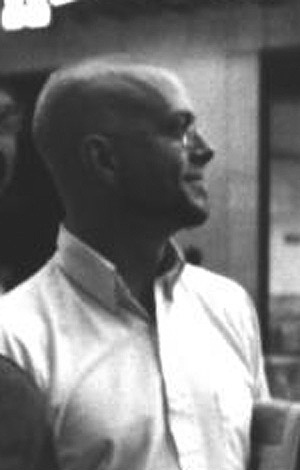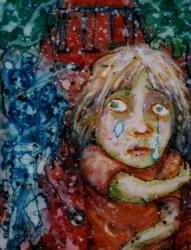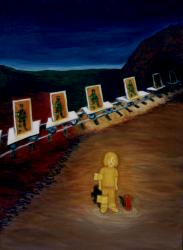The Column: When Artmaking Is Integral to Life
Christian McShane describes the experience of seeing paintings that he loves.



In my world there are three kinds of artists: those who have it,
those who struggle with it, and those who talk about it.
Those who talk about it are the least interesting. I mean, the kind that immediately announce that they are artists and are all too willing to explain why. I don’t know why they bother with doing the art—they’re better at being salespeople, the Ron Popeils of art.
Those who struggle with it are the group that most of us fit into. We’re
not Carravaggios. We’ve often had some kind of schooling or study, however minimal or maximal, and do art in some fashion. But we struggle. Ours is a lifelong struggle to better understand ourselves and the world around us through art. And maybe, if we work at it hard enough and long enough, we’ll come up with one or two great pieces of art before we die. We don’t know why we insist on beating ourselves up like this, but we keep at it.
Those who have it belong to an extremely small group of people. They are
the ones who belch art. People admire them and are jealous at the same
time. What takes strugglers years and talkers a thesis, they do with
unnerving ease. They are the ones who make you stop in your
tracks. To stop time is miraculous, but that’s what they do. They pull us out of our lives and make some sense of it all. When I see this kind of thing, I say “Yeah…. that’s it.” Then I stand there a long,
long time. Someone could hit me with a shovel.
Let me tell you how all this started.
I curate a show called “experimental Tuesdays” (or “e.t.”) here
in Duluth. The idea is to provide a stage for any and all kinds of
experimental art; be it visual or audible. Our hope in the beginning was
that we’d get artists involved that fell through the cracks–people doing art in the secrecy of their own bedrooms and basements for no one to hear or see. We hoped to provide a haven for artists that had nowhere in the mainstream to show their work. So far, it’s been an unbelievable success.
Not long after we began, a woman with wild red hair shyly walked up and
asked if she could play at e.t. sometime. I didn’t even know her name.
I just said, “Sure, give me a call.” After she walked away, Alan
Sparhawk (of Low) looked at me with a big smile and said, “She’s gonna
be
And she was. Some weeks later, she called me. She talked so soft that I
misprinted her name on the posters. The Tuesday finally came for her
performance and she showed up with an accordion, a keyboard, and a poet.
She seemed painfully shy. I tried my best to make the environment as comfortable as possible, knowing how foreboding it can be to be all alone on a big stage. I slowly adjusted two microphones–one for accordion and one for vocals–and told her in a low voice,
“OK, go for it…” The performance lasted 20 seconds. I didn’t even have
time to press “play” on my camcorder.
It was the best performance I’d heard. I couldn’t clap loud enough and I
couldn’t stop smiling. This was what e.t. was all about. And just like
that – poof, she was gone. That was all I ever saw of the shy little
woman with the wild red hair.
Many months later, I received a postcard in my regular mail wedged
somewhere between the power bill and yet another
free!
to work. Little did I know I was carrying a small masterpiece
slung over my shoulder. Later that day as I opened my mail, out popped a
postcard invitation for an exhibition.
On the front was a watercolor painting titled
Stoning,
the card for a long time like I was holding a baby bird in my hands. I
carefully put a pin in the top center margin of the card and pinned it
to my wall, careful not to poke a hole anywhere near where the painting
began. I sat back and took in a wider view. Then I took it
down and looked at it closely again. Bridget Riversmith made my time
stop.
It comes as no surprise that she was told early on by art teachers to
forget about making art and choose another direction in life. Thankfully, she didn‚t listen to them. She couldn’t because art is what Bridget Riversmith is, not what she does. I’m always amused when artists, writers and musicians think they‚re being profound when they say, “It’s what I do.” Never have I heard, “It’s what I am.”
I have a friend who loves looking at rocks and bones. I have another friend who loves the sound of the wind. At its core art is simple. It’s a form of communication. The problem many times is that we try too hard.
We overcomplicate it until it doesn’t communicate anything to anyone but
the artist. We talk too much, inward and outward. Most times, we should
just shut up and do. We shouldn’t be afraid to show what’s really in
there – inside each of us. The happy parts, the scary parts, the sad
parts, the silly parts – all of it. What I really want to see or hear is
an intimate piece of the artist: honesty.
And Riversmith is honest, sometimes brutally so. She doesn’t mock or emulate. What you get is a tiny piece of her own self. Hers is art rubbed raw. Whimsical, childlike, scary, gutsy, her work cuts deep inside and touches the little one in us. The frightened child, the hurt child, the lost child, ever the child. We’ve all been there. It’s the time you woke up in the middle of the night and didn’t know
where you were. The time you called for your parents and they weren’t
there. The time when you realized that life really is a solo gig, no
matter how much we shudder to fathom the thought. That place is where Riversmith lives.
Bridget Riversmith is showing through Sept. 30 at Adeline Inc. in the Building for Women, 32 East First St., Duluth.